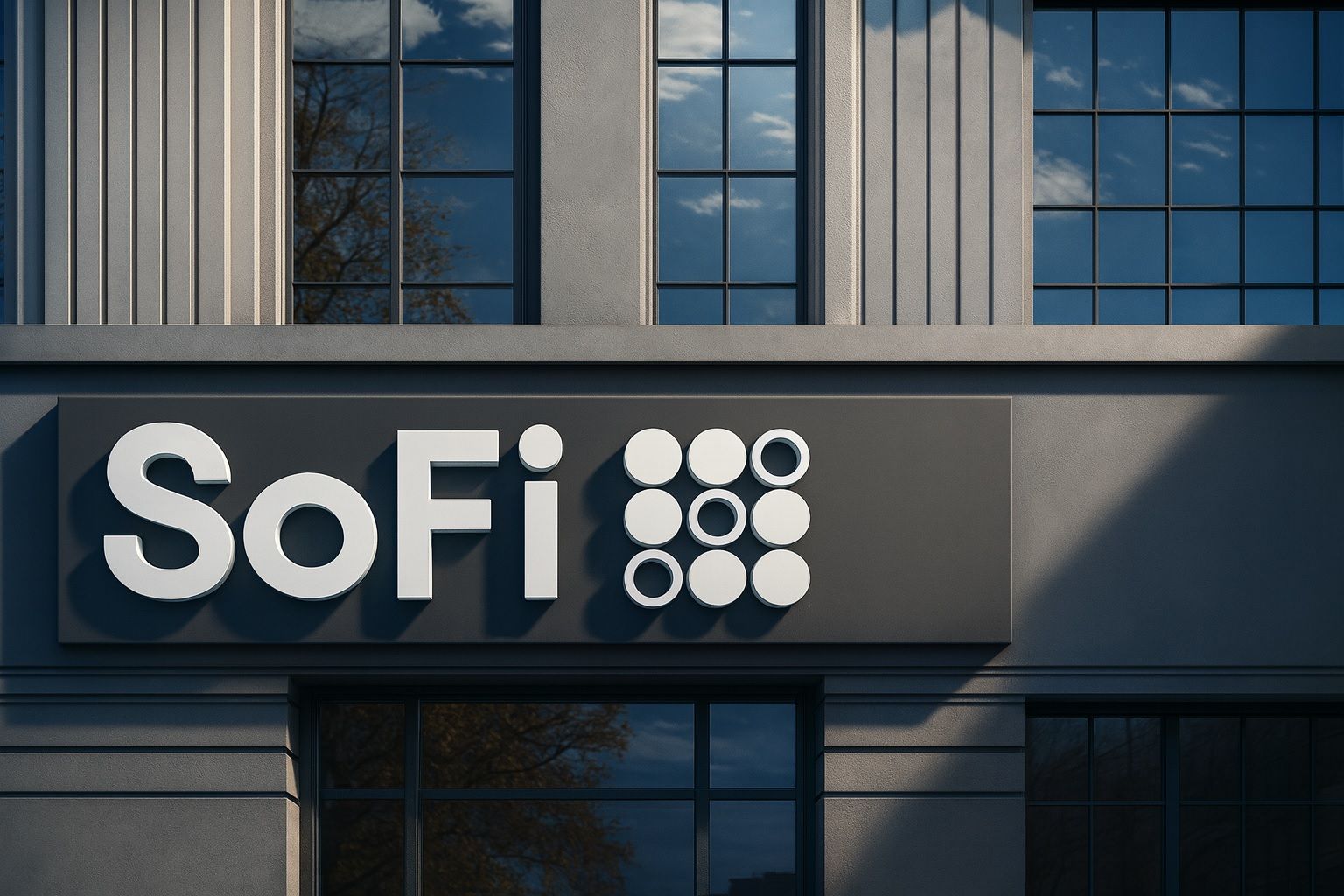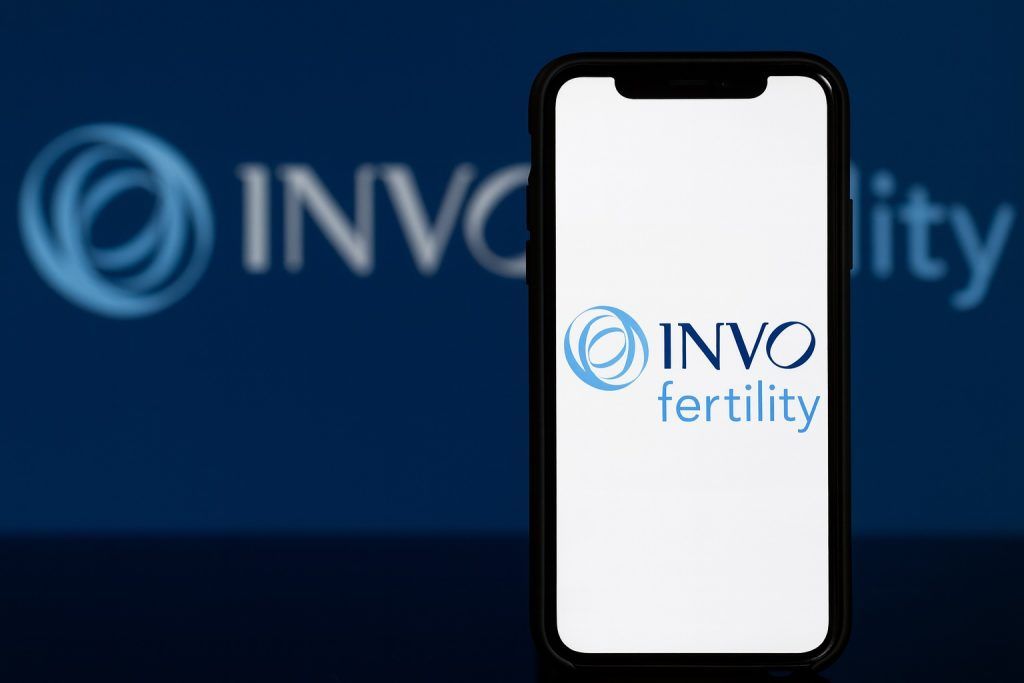- Blistering 2025 Rally: SOFI stock surged about 230% over the past year, hitting a 52-week high around $30.30 in late September [1]. It has since pulled back on profit-taking, closing at $26.60 on Oct. 16 after a 5% one-day drop [2]. Even after the dip, shares remain up ~70% year-to-date [3].
- Upcoming Earnings Catalyst: SoFi will report Q3 2025 earnings on Oct. 28. Analysts expect another strong quarter, with consensus EPS of ~$0.08 on $880+ million revenue [4] (roughly +60% EPS growth YoY). The company already surprised to the upside in Q2 (posting $0.08 vs $0.06 expected) and raised its full-year revenue guidance to ~$3.37 B (+30% YoY).
- New Product Launches: The company is aggressively expanding its fintech “super-app.” In early October, SoFi launched fee-free options trading for retail investors, allowing beginners to trade covered calls and puts with zero commissions or contract fees [5] [6]. It also rolled out a new AI-focused ETF (NASDAQ: AGIQ) in September, targeting next-gen “agentic” AI companies like Tesla and Nvidia [7].
- Crypto & Payments Push:Crypto payments are next on SoFi’s roadmap. CEO Anthony Noto announced plans to enable blockchain-based international transfers in the app by late 2025, via a partnership with Bitcoin Lightning startup Lightspark [8]. The service (piloting in Mexico) promises low-cost, instant remittances. SoFi even intends to launch its own FDIC-insured stablecoin once regulators green-light it [9]. Noto says these moves will give members “faster, smarter, and more inclusive access” to their money through crypto tech [10].
- Leadership & Regulatory News: SoFi’s fintech infrastructure arm Galileo saw a leadership shakeup in October – long-time CEO Derek White stepped down (after posting “record revenue” and a “Rule of 40” quarter), and CFO Bill Kennedy was promoted to CEO [11]. On the policy front, investors are watching U.S. student loan news: a recent report suggested the Treasury might sell off federal student debt to private lenders [12], a potential $1.6 T market opportunity that could benefit SoFi’s refinancing business.
- Analyst Divergence: Wall Street is sharply divided on SOFI. Bears argue the stock is overvalued after its massive run – Morgan Stanley pegs fair value around $18 and Compass Point around $12, both rating SoFi “Sell” [13]. Yet bulls see further upside: Mizuho recently reiterated a Buy with a $31 target, citing SoFi’s “strong rate-driven outlook” and accelerating growth [14]. Overall, the consensus rating is Hold with an average price target near $21 [15] [16], implying the stock may already reflect much of its good news.
SOFI Stock Price: 2025 Surge and Recent Volatility
After a spectacular rally through 2025, SoFi’s share price has been on a roller coaster in recent weeks. The stock more than tripled in the past year, climbing from the single digits to a high of about $30.30 by late September [17]. That ~230% year-over-year gain far outpaced most fintech and bank stocks. However, the euphoria has cooled slightly in October: SoFi pulled back roughly 10% from its peak, trading in the mid-$20s as some investors took profits [18].
The past week highlighted SoFi’s high volatility. Shares briefly rebounded above $28 mid-week, then slid 5.1% on Thursday (Oct. 16) to around $26.60 [19]. Volume was heavy (72+ million shares traded that day, about 16% above average) [20], underscoring the stock’s popularity – and susceptibility to swings. Analysts note that SoFi declined for seven straight sessions in early October amid broader market jitters and a couple of high-profile downgrades [21]. Many see this dip as a healthy breather after SoFi’s parabolic rise. Indeed, at ~1.9 beta, the stock is nearly twice as volatile as the market [22], so 5–10% pullbacks aren’t unusual on its ascent.
From a technical analysis perspective, SoFi’s chart is nearing a key test. The shares are pulling back toward their 10-week moving average, a support level that in the past has steadied the stock during big rallies [23]. If that support holds, it could signal a bullish continuation of the uptrend. Many market technicians actually welcome the recent consolidation as a chance for the stock to “digest” its gains – essentially resetting indicators from overbought levels while the fundamental narrative remains positive. Even after the pullback, SoFi is still up roughly 70% year-to-date [24], dramatically outperforming the S&P 500 and the broader fintech sector. The question is whether the upcoming catalysts (like earnings) will re-ignite the rally or if the stock will continue to hover in a volatile trading range near current levels.
Recent Developments: Growth Moves on Multiple Fronts
SoFi’s management has been extremely busy expanding the platform, unveiling new products and partnerships that could drive future growth:
- No-Fee Options Trading: On October 2, SoFi launched commission-free options trading for eligible members – a move first reported by Bloomberg [25]. This “Options Level 1” offering lets beginner investors trade basic options strategies (like covered calls and cash-secured puts) directly in the SoFi app with zero commissions or contract fees [26]. According to CEO Anthony Noto, offering lower-risk, fee-free options was one of the “most consistent requests” from SoFi Invest users [27]. By eliminating per-contract fees and even waiving exercise/assignment fees, SoFi is clearly aiming to boost engagement on its investing platform [28]. The company indicated it will roll out more advanced options levels over time (including options in retirement accounts and even same-day expiration trades) along with new tools for options screening and strategy-building [29]. This expansion comes on the heels of SoFi broadening into alternative investments (like pre-IPO shares and venture funds) and relaunching its robo-advisor with BlackRock, underscoring its strategy to make SoFi’s app a one-stop shop for investors.
- AI Investment Products: In September, SoFi debuted the SoFi “Agentic” AI ETF (AGIQ) – a new thematic exchange-traded fund focused on companies advancing the next generation of AI. The ETF tracks U.S. stocks involved in “agentic” artificial intelligence (AI that can adapt and act autonomously), holding names like Salesforce, Tesla, and NVIDIA [30]. “We’re excited to add AGIQ to our ETF suite to give members another opportunity to tap into the next evolution of AI,” said SoFi’s Head of Advice, highlighting the company’s push to offer cutting-edge investment themes to its users [31]. This fund joins a growing roster of SoFi-branded ETFs (which already cover themes like Web3, fintech, and the gig economy), and expands SoFi’s presence in the asset management space. The timing capitalizes on intense interest in AI-driven stocks – a savvy move to attract investors looking for exposure to the AI boom.
- Crypto and Payments Initiatives: SoFi is also leaning into crypto and blockchain as it evolves from an online lender into a broader fintech platform. On the same day as the options rollout, Noto announced a suite of upcoming “crypto-powered” features for SoFi [32]. By the end of 2025, SoFi plans to enable direct crypto trading (letting members buy and sell major cryptocurrencies) and introduce self-serve international transfers via blockchain [33]. Underpinning the latter is a new partnership with Lightspark, a startup building on the Bitcoin Lightning Network. SoFi first unveiled this collaboration in August, and it will allow SoFi users to send money overseas instantly with minimal fees via Lightning – initially between the U.S. and Mexico, with more corridors to follow [34]. “We want to give members faster, smarter, and more inclusive access to their money,” Noto said of the crypto integration, emphasizing how blockchain could make global payments more efficient [35]. Additionally, SoFi intends to launch its own stablecoin (a cryptocurrency pegged to the U.S. dollar) that would be FDIC-insured, pending regulatory approval [36]. If it comes to fruition, an FDIC-backed stablecoin would be quite innovative – essentially a bank-issued crypto token – and could be used for instant spending and transfers within SoFi’s ecosystem. These initiatives show SoFi’s determination to stay on the fintech cutting edge, though they also introduce new regulatory and execution risks (more on that later).
- Galileo Shake-Up: In early October, SoFi announced a major leadership change at its key technology subsidiary Galileo. Galileo is the API and payments platform (acquired by SoFi for $1.2 B in 2020) that powers the backend for numerous fintech apps. Its CEO Derek White resigned after four years at the helm, during which Galileo’s client base and revenues grew rapidly [37]. In a LinkedIn post, White noted he was leaving with Galileo at “record revenue” and having achieved a “Rule of 40” quarter (a metric indicating that its revenue growth plus profit margin sum to 40% or more – a sign of a healthy SaaS business) [38]. SoFi promoted Bill Kennedy, Galileo’s CFO, to take over as CEO [39] and thanked White for his contributions. This marks one of the biggest executive transitions at SoFi in 2025. While leadership churn can be unsettling, the company implied that Galileo’s momentum remains strong. (Notably, Galileo recently enabled SoFi to offer early paycheck access and other banking features that have helped drive SoFi’s user growth.) Analysts will be watching how the new leadership at Galileo executes on further integrating the platform with SoFi’s services and supporting external fintech clients – a critical component of SoFi’s B2B revenue stream.
- Student Loan Overhang and Policy News: SoFi’s roots are in student loan refinancing, so any news in the student debt arena is highly significant. With the post-pandemic resumption of federal student loan payments this fall, SoFi and other private lenders have hoped to see refinancing activity pick up (after a lull during the payment pause). Now a potential bombshell policy shift has emerged: Politico reported that the U.S. Treasury is exploring selling off portions of the $1.6 trillion federal student loan portfolio to private investors [40]. If such a plan were enacted, it could create a huge new market for private refinancing and consolidation – benefiting companies like SoFi that could purchase and service those loans. So far this is just a proposal, and it faces political hurdles, but the mere possibility has been noted by the market. SoFi has long lobbied for measures to open up the student loan market, arguing that creditworthy borrowers should have options to refinance federal loans at lower rates. On the flip side, the current White House administration is seen as less likely to privatize student debt (compared to the prior administration) [41]. SoFi investors will be keeping a close eye on Washington: any concrete moves on student loan asset sales or alternative relief programs could swing SOFI stock. More broadly, regulatory shifts are a double-edged sword for SoFi. For instance, crypto regulation is another area of focus – recent guidance has been more crypto-friendly, which bolsters SoFi’s plans to expand crypto trading and possibly launch that stablecoin [42]. But unexpected changes (in banking rules, consumer lending laws, etc.) could pose risks. In short, SoFi is operating at the intersection of tech and finance, so it must navigate an evolving policy landscape as it expands.
Bull vs. Bear: What the Experts Are Saying
Wall Street’s take on SoFi is sharply split, reflecting its high-flying promise but also high valuation. The current analyst consensus rating is essentially Hold. According to TipRanks and MarketBeat data, SoFi has about 5 “Buy” ratings, 9 “Hold”, and 4 “Sell” ratings [43], and the average price target is roughly $20–$21 per share [44] [45]. That average target sits below the current stock price – implying 10–20% downside – which signals that many analysts feel SoFi’s rapid growth is already “priced in” at recent levels [46].
On the bearish side, several analysts urge caution after the stock’s torrid run-up. Morgan Stanley’s Jeffrey Adelson, for example, reiterated his Underweight (Sell-equivalent) rating even as he bumped his price target from $13 up to $18 [47]. Adelson argues that after a nearly 250% rally in less than a year, “the optimism is already priced in” to SoFi’s stock [48]. Similarly, Compass Point has a Sell with a $12 target, voicing concerns that SoFi’s valuation has sprinted far ahead of its fundamentals [49]. These skeptics point out that SoFi trades at roughly 47× forward earnings – an earnings multiple more typical of a hyper-growth tech company than a bank – and that leaves little margin for error if growth slows [50]. Some also note rising competition and macro risks: SoFi’s reliance on lending means it could be hurt if interest rates stay higher for longer, crimping loan demand (or if a recession increases credit losses). “Most buyers are already in,” one analyst quipped about SoFi’s meteoric run, cautioning that the pool of new investors willing to push the stock even higher may be dwindling [51].
On the bullish side, many observers see SoFi as a fintech leader with years of growth ahead – and they think the stock will ultimately justify its premium valuation. One of the most outspoken bulls, Mizuho’s Dan Dolev, recently reiterated his Buy rating and raised his price target to $31 [52]. Dolev argues that SoFi’s growth story is actually entering a new phase: he expects interest rate cuts in 2025 (after the Fed’s tightening cycle) to boost SoFi’s lending volumes and margins, and he points to core business metrics that remain very robust [53]. In Q2 2025, for instance, SoFi’s revenue jumped 44% year-over-year while its member base grew to record levels [54] – evidence that cross-selling and product expansion are working. Other bulls highlight SoFi’s bank charter (unique among fintechs) as a competitive advantage that allows it to fund loans with deposits, keeping costs low. Needham recently upped its target to $29 (from $25) and maintained a Buy, citing improving funding conditions in digital lending [55]. Additionally, William Blair analysts came away “confident in the company’s growth outlook” after meeting with SoFi’s management, maintaining an Outperform rating (equivalent to Buy) [56]. The bullish thesis is that SoFi can continue scaling at a rapid clip – potentially 30%+ revenue growth per year – given its expanding product suite and the massive market for disrupting traditional banks. If SoFi delivers on its own targets (e.g. management is aiming for about $0.55–$0.80 in EPS by 2026), then today’s valuation multiples may start to look more reasonable in hindsight.
Importantly, even optimistic analysts acknowledge the rich valuation and the need for execution. At ~47 times forward earnings and about 10× sales, SoFi is priced for perfection [57]. Bulls believe those earnings will materialize as SoFi’s financial services segment (checking/savings, credit cards, investments, etc.) matures – that unit saw 52% revenue growth in Q2 [58], a promising sign that SoFi’s cross-selling strategy is working. But any stumble – a missed earnings report, a spike in loan defaults, a regulatory hiccup – could trigger a sharp correction when expectations are this high. “One of the deepest ironies” of a hot stock, notes Money Morning columnist Joshua Enomoto, is that its very success begets new challenges [59]. After such a large rally, many investors start to “fear holding the bag” – worried that if they buy in late and growth falters, they could face steep losses [60]. This dynamic is likely at play with SoFi: it’s a momentum darling, but also a stock where sentiment could shift quickly if future results don’t live up to the hype. All that said, the near-term focus is on the upcoming Q3 earnings call (Oct. 28), which is shaping up to be a showdown between bullish and bearish narratives. SoFi has delivered seven consecutive quarters of GAAP profitability [61], a streak the bulls will expect to continue. Any updated guidance from management – say, on 2024 metrics or new product adoption – will be parsed for signs that SoFi can sustain its torrid growth into 2026. In short, expect intense debate when SoFi opens its books at month’s end [62].
Fintech Industry Context and Competitive Landscape
SoFi’s dramatic rise comes amid a broader fintech renaissance this year – but also intense competition. The company occupies a unique spot as a modern “financial super-app”, offering everything from banking and loans to stock trading, crypto, insurance, and more under one roof. This contrasts with many peers that remain focused on niches. For example, Affirm is a buy-now-pay-later lender still struggling to reach profitability, and Robinhood is primarily a trading app that has seen growth level off post-pandemic. In fact, among consumer fintechs, SoFi is one of the few that’s consistently profitable and growing at scale [63] [64]. Its diversified model – combining a nationally chartered bank (SoFi Bank), an investment brokerage, a lending operation, and technology services (Galileo/Technisys) – gives it multiple ways to earn revenue and cross-sell products to its ~6.2 million members (as of Q2).
Traditional financial institutions are paying attention. Large banks like JPMorgan and fintech stalwarts like PayPal have all been expanding their offerings to compete for digitally savvy customers. But SoFi’s all-in-one approach and hip brand have helped it win a loyal following in the coveted millennial and Gen Z demographics. In 2025, SoFi has been adding about 0.5 million new members per quarter – growth that legacy banks could only dream of (albeit from a smaller base). This highlights both the opportunity and the challenge: SoFi is taking share in consumer finance, but it’s still a relative upstart competing with giants that have far larger customer bases.
Comparative valuation also draws debate. SoFi’s current ~$30 billion market cap (at ~$26/share) now exceeds that of many regional banks that have tens of billions in assets [65]. And as noted, SoFi stock trades at valuations (nearly 50× forward earnings) much higher than established payment and fintech players: for context, PayPal and Block (Square) trade around 12× to 21× forward earnings [66]. Even other tech-forward lenders like LendingClub are at ~23× earnings [67]. So investors in SoFi are effectively betting that it can sustain rapid growth for years to come, eventually narrowing that valuation gap by boosting its earnings. There is precedent for richly valued disruptors eventually “growing into” their multiples – consider early Amazon or Tesla – but it requires flawless execution. SoFi will need to keep launching successful products, managing its lending risk, and attracting new customers at a high rate to justify the optimism embedded in its stock.
Key risks to watch in the industry context include interest rate trends and credit conditions. As a lender, SoFi benefited from refinancing booms when rates were low; now it faces the flip side of higher rates potentially damping demand for loans or making customer acquisition more costly. The flip side is that if the Federal Reserve shifts to rate cuts in 2025, that could spur a refinancing wave (for student loans, mortgages, personal loans) which plays directly into SoFi’s wheelhouse – a point the bulls highlight [68]. Economic conditions matter too: So far, U.S. consumers have been resilient, and SoFi’s loss rates on loans have been stable. But in a downturn, defaults could rise, testing SoFi’s underwriting and potentially slowing its growth (as happened to some fintech lenders in past credit cycles).
Another factor is competition from incumbents. Big banks are not standing still – for instance, traditional banks have rolled out early wage access, high-yield savings, and other features that mimic fintech offerings. Tech giants like Apple and Google are also encroaching on personal finance. SoFi’s advantage is its head start in creating a unified digital finance platform, plus its ability to move quickly on innovation (e.g. crypto Lightning transfers, which few banks offer). Still, as SoFi grows, it increasingly draws attention from larger rivals that have deeper pockets. The company will have to execute well on its marketing and maintain its tech-savvy image to continue attracting customers away from incumbents.
On the regulatory front, SoFi’s bank charter (obtained in early 2022) is a double-edged sword: it gives SoFi access to stable deposit funding and the ability to offer banking services, but it also puts SoFi under stricter regulatory scrutiny (from the OCC, FDIC, Fed, etc.). Any compliance issues or capital requirement changes could pose headaches. Furthermore, crypto activities will be watched by regulators – SoFi has already faced questions from Congress about its crypto trading offerings, and launching a stablecoin might invite new oversight. Conversely, if regulators provide clarity and green lights (as seen with recent guidance that was somewhat crypto-friendly [69]), that can embolden SoFi’s efforts in blockchain finance.
In summary, SoFi operates at the crossroads of banking and tech. Its ambitious aim is to be “the Amazon of finance”, an integrated platform where customers do all their money-related activities. 2025 has shown that this vision can generate serious growth – and a surging stock price – but the company must navigate competitive, macroeconomic, and regulatory challenges in the coming years. So far, SoFi has proven adept at zigzagging into new product areas (often outpacing much larger competitors in innovation). The broader fintech sector’s fortunes will likely rise and fall with factors like interest rates, consumer confidence, and tech trends (AI, crypto, etc.), all of which will influence SoFi’s trajectory as well.
Outlook: High Hopes and Key Events Ahead
With SoFi’s stock up so dramatically this year, investors are now looking ahead to see if the company can keep delivering on the hype. The next major event is the Q3 earnings report on Oct. 28, which will offer a crucial check-in on SoFi’s momentum. Management’s commentary on member growth, deposit flows, and loan demand will be especially telling, as will any updates to 2025 guidance. Given the heightened scrutiny, even a small earnings beat or miss could spur outsized stock moves. Bulls will be looking for confirmation that SoFi’s profitability is steadily improving (Q2 2025 net income was $97M, a huge jump from $8M a year prior). Bears, on the other hand, will be dissecting SoFi’s expense levels and loan performance for any cracks in the growth story.
Beyond earnings, a few specific developments could sway the stock in coming months. One is the rollout of the new crypto and payment features – if SoFi indeed launches Lightning Network transfers or a stablecoin by year-end, it could open up new revenue streams (and generate buzz among crypto enthusiasts). Another is the macro environment: if inflation eases and the Fed signals rate cuts in 2025, fintech lending stocks like SoFi could catch an additional tailwind as borrowing accelerates. Conversely, if rates stay high or the economy slows, SoFi’s growth might moderate, validating some of the cautious outlooks.
Investor sentiment will also be influenced by how SoFi’s peers perform. The fintech sector has seen a rebound in 2025, but some players (like PayPal) have struggled with slower growth, while others (like Upstart or LendingClub) remain well below their peak valuations. If SoFi continues to outshine its competitors on growth and execution, it could attract more institutional investment as a “best of breed” fintech. Notably, large institutions already own roughly 38% of SoFi’s shares [70], and while Cathie Wood’s ARK Invest made headlines by trimming its SoFi stake recently, other funds have been buyers on dips [71]. That institutional interest provides some support, though insiders at SoFi have used 2025’s rally as an opportunity to sell portions of their holdings – about $425 million in stock was sold by insiders over the past year [72] (including sales by the CTO and at least one director). Even CEO Anthony Noto monetized a chunk of his stake via a prepaid forward contract covering 1.5 million shares (around 7% of his holdings) [73]. While insiders still appear confident in SoFi’s long-term vision, such sales do add a note of caution, as they often precede periods of consolidation after big run-ups.
Ultimately, SoFi’s story encapsulates both the promise and peril of disruptive fintech. The company has transformed from a niche student lender into a diversified financial platform at a time when digital finance is booming. That bold expansion – into banking, brokerage, crypto, and beyond – has won it fervent believers as well as skeptics. “SoFi’s stock story is a dramatic one,” one analyst aptly summarized – driven by genuine growth and innovation, but now shadowed by a “lofty valuation” and the need to live up to high expectations [74]. Going forward, investors should keep a close eye on a few things: earnings consistency, to see if SoFi can maintain its profitable streak; user growth, to ensure its costly marketing pays off in continued member gains; credit quality, to watch for any deterioration in its loan book; and regulatory signals, especially around crypto and student loans, which could unlock new opportunities or raise new hurdles.
For now, SoFi remains one of the most intriguing stocks in fintech – a high-flying, ambitious company at the intersection of tech and banking. It could prove to be a big winner if the company executes flawlessly and becomes the go-to financial platform for a generation. Or, if growth stalls or external conditions turn, it could hand latecomers a painful lesson. As the saying goes, fortune favors the bold – both for SoFi as a company, and for investors deciding whether to ride this exhilarating (and at times bumpy) fintech journey. The coming months, starting with that Oct. 28 earnings report, should provide a clearer signal as to which way SoFi’s story will turn next [75].
Sources: Key information in this article was drawn from SoFi’s official reports and press releases, analyst commentary on TipRanks and Money Morning, and news coverage by Bloomberg, Yahoo Finance, Investing.com, MarketBeat and TechSpace 2.0 (ts2.tech) [76] [77] [78], among others. All data are current as of Oct. 17, 2025.
References
1. ts2.tech, 2. www.marketbeat.com, 3. ts2.tech, 4. ts2.tech, 5. www.investing.com, 6. www.investing.com, 7. ts2.tech, 8. ts2.tech, 9. ts2.tech, 10. ts2.tech, 11. ts2.tech, 12. ts2.tech, 13. ts2.tech, 14. ts2.tech, 15. ts2.tech, 16. www.marketbeat.com, 17. ts2.tech, 18. ts2.tech, 19. www.marketbeat.com, 20. www.marketbeat.com, 21. ts2.tech, 22. ts2.tech, 23. ts2.tech, 24. ts2.tech, 25. ts2.tech, 26. www.investing.com, 27. www.investing.com, 28. www.investing.com, 29. www.investing.com, 30. ts2.tech, 31. ts2.tech, 32. ts2.tech, 33. ts2.tech, 34. ts2.tech, 35. ts2.tech, 36. ts2.tech, 37. ts2.tech, 38. ts2.tech, 39. ts2.tech, 40. ts2.tech, 41. ts2.tech, 42. ts2.tech, 43. ts2.tech, 44. ts2.tech, 45. www.marketbeat.com, 46. ts2.tech, 47. ts2.tech, 48. ts2.tech, 49. ts2.tech, 50. ts2.tech, 51. ts2.tech, 52. ts2.tech, 53. ts2.tech, 54. ts2.tech, 55. www.investing.com, 56. www.investing.com, 57. ts2.tech, 58. ts2.tech, 59. ts2.tech, 60. ts2.tech, 61. www.sec.gov, 62. ts2.tech, 63. ts2.tech, 64. ts2.tech, 65. ts2.tech, 66. ts2.tech, 67. ts2.tech, 68. ts2.tech, 69. ts2.tech, 70. ts2.tech, 71. ts2.tech, 72. ts2.tech, 73. www.investing.com, 74. ts2.tech, 75. ts2.tech, 76. ts2.tech, 77. ts2.tech, 78. www.investing.com







